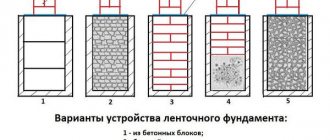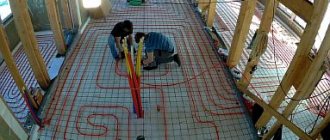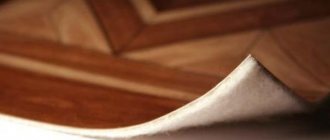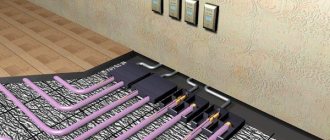Thermal electric mats
If we take into account that tiles are often laid on the floor in the hallway, then electric thermal mats are ideally suited for the hallway.
Thermal mats are sold in finished form, according to the dimensions calculated in advance. A floor calculation can be done for you in the store. If we take into account that thermal mats are not placed under furniture, the number of mats for the hallway will be minimal.
The readiness of purchased mats allows us to minimize installation work. They are relatively unpretentious to install. A level base, space for installing the regulator and a power supply are required. There is no need to do special covering work for them; the tiles are laid directly on rolled out mats, and they are covered with tile adhesive.
However, mats also have disadvantages. It is better to cover thermal mats with tiles or porcelain stoneware, and if you plan to use wood-based coatings for finishing the floors, it is better to choose a different type of heated floor. For example, film heated floor.
What other flooring can be made in the hallway using less durable materials?
But if you live alone in an apartment or with a small family, and no one is running or jumping along the corridor, then the flooring in it can be made from a less durable material.
In order for the flooring to last longer, you need to carefully prepare the base for it. The floor must be perfectly flat, especially in the hallway. If there are slopes and depressions, then a screed should be made so that the coating does not press through and does not diverge at the joints.
A good material for the flooring in the hallway is parquet, especially oak. Oak is a hard wood and, like all of them, is strong and durable, and is also resistant to abrasion. The parquet floor looks simply gorgeous. But parquet is a rather expensive material, and it is not suitable for everyone for financial reasons. Therefore, as an option, you can choose its imitation from laminate.
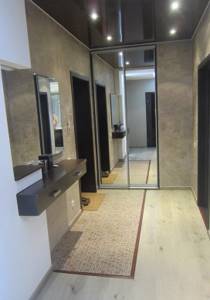
Now laminate is produced in a wide variety of colors and shades, there are options for valuable wood species. It looks good, is not much inferior in aesthetics to natural boards, has excellent performance characteristics, is abrasion resistant, strong and durable. There are different categories of laminate. Its resistance to mechanical stress is greater, the higher the class of the material. Therefore, laminate is an excellent alternative to both tiles and parquet for hallway floors.
Unsuitable covers
Linoleum, much less cork, is not suitable for the floor in the hallway. These materials do not have sufficient strength and are intended for flooring in living rooms.
Cable heated floor
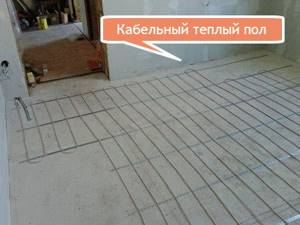
Cable heated floors are heated with an electric cable, similar to those in thermal mats, but with more complex installation. Installation of this type of heated floor is much more complicated than those listed above.
- The heat cable is laid on a concrete base, which must be covered with reflective material.
- To install the cable, you need to install special holders, and the cable itself needs to be laid according to a complex pre-calculated pattern.
- But most importantly, the electrical cable for the heated floor must be covered with a layer of screed to ensure uniform heating and protection of the cable. Such a shelter allows you not to think about the arrangement of future furniture, and install warm floors over the entire floor area.
Such technological complexity of installation makes it unprofitable to use it only for the hallway. However, a cable heated floor in the hallway can perfectly become part of an overall cable floor system for the entire home.
Advantages of installing heated floors in the hallway
- Economy. The design heats the area as much as possible, as it is equipped with thermostats that maintain the temperature appropriate for the home owner without consuming additional energy.
- Environmentally friendly. Dust does not rise into the air and does not penetrate the human respiratory tract, as happens when heating a room with radiators.
- Versatility. The heating design does not interfere with furniture arrangement and does not take up space. To do this, you need to choose any appropriate system: water, electric or film.
- Practicality. Warming up protects against drafts coming from the front door. The air in the room is heated to a height of one and a half meters throughout the entire area. Right there, at the entrance, you can create a warm place for your pet.
Water heated floor
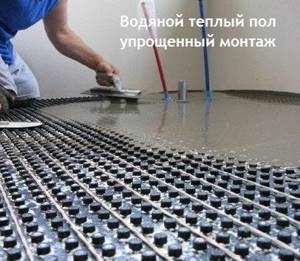
- Water heated floors are the most complex floor heating system. It makes no sense to consider it as a separate system for heating the hallway.
- The use of a water heated floor system in the hallway can only be considered as part of the overall heating system for the house with water floors.
- The difficulties of a water heated floor include a separate water supply, complex and expensive installation of water distribution and circulation, covering with a screed, difficult startup and operation.
Reasons for installing heating in the hallway
The hallway is considered the place that determines the first opinion of guests about the house. Therefore, it is worth thinking about materials for finishing the room, because a correctly selected design creates a feeling of harmony. Well, a heated floor in the room will add comfort.
If it is snowing or raining outside, then a warm floor helps eliminate moisture - it is used to dry shoes. Moisture is unacceptable for shoes, and by placing them on a warm surface, they can be dried evenly.
Coming home from the street, it’s nice to take off your shoes and step on the heated floor. It is laid under such popular flooring materials for the corridor as laminate, tile, porcelain stoneware.
Selection of underfloor heating system
Having decided to upgrade the heated floor, the main thing is to choose the appropriate design for heating. The selection depends on the floor covering option, financial capabilities, your own desires and who carries out the installation process (a team of employees, personally).
Water heating
Layout of hydraulic heating system pipes
Floor heating systems are used all the time: in office premises, apartments, and houses. In its own design, it has elastic plastic pipe contours in which hot water moves. Heating is controlled using a conventional room thermostat. If the installation process is done properly, the likelihood of a leak is zero. The heating system has a low price and does not have electromagnetic radiation.
Attention! This design takes into account raising the floor level to the height of the screed - up to 10 cm.
Cable floor heating electric sample
Layed wire in the hallway
The heating system consists of an electric cable (single- or two-core), laid under a concrete screed, and a temperature controller. This heating
Best suited for installation under ceramic tiles and other coatings. They install it in the hallway, kitchen, bathroom and even in living areas. The advantage of such a system is that the installation process is not difficult, but the cable floor is expensive to operate due to excessive consumption of electrical energy.
Electric mats for heated floors
If we compare it with laying a cable floor, then the process of installing mats can be performed by any home craftsman. The mats are laid without screed - glue is used. In such a heating system, an electric cable with the required pitch is placed on the grid. Thanks to this, all that remains is to cut the mesh and place the mats. The main thing is to make sure that the loops of the electrical cable do not intersect each other or touch each other. The disadvantage of the system is that heavy objects (chest of drawers, wardrobe) cannot be placed on the mats, so you will have to design the arrangement of furniture in the hallway in advance
Infrared heated floor
Heating film installation process
Warm film flooring is in demand due to its ease of installation. Anyone can install it with their own hands, especially since the manufacturer sells these products in kits. The installation kit includes electrical wiring, thermal film, insulation, external water thermostat, temperature sensor. The system operates on the basis of infrared radiation. Such heating is installed under ceramic tiles, carpet and other coverings. It is suitable for installation in a corridor : the cost of electrical energy is low, a concrete screed is not required. And most importantly, if any part breaks down, the heated floor continues to operate normally.
It is, of course, up to the home owner to choose which heated floor should be placed in the corridor space, but the financial investment will primarily pay off in convenience and coziness. This allows you to raise the temperature in the corridor space and apartment during the cold season.
Heated floor in the hallway:
Porcelain tiles
Those who do not like to change traditions certainly prefer porcelain stoneware or tiles. They meet all the requirements necessary for the operation of the hallway. These are the easiest floors to clean; even caustic detergents are of no use to them. Their only drawback lies in the expensive and longer installation.
There is a special anti-slip tile for the hallway. As a rule, its surface is matte and has a relief.
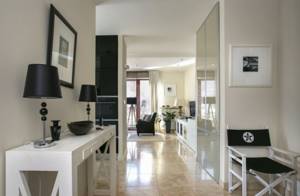
For a classic interior this is the most suitable option. For spacious hallways with an open area, choose tiles that imitate modular parquet, as in the photo.
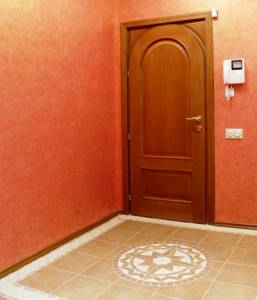
For connoisseurs of ceramic aesthetics, it is recommended to choose Metlakh tiles for the hallway design. Original design and unique ornament will bring beauty and expressiveness to the interior. But such a floor will not suit the modern style of hallway design.

Carpet or carpet tiles
Not the most practical solution, or rather the most unsuitable for the room in which outdoor shoes are located. If you really want to have a textile floor everywhere at home, it is recommended to lay out the very entrance to the house with a more practical covering. And further from it the carpeting is already laid.
Combining floors is a convenient solution when you need to combine comfort and practicality.
The modern version of carpet is carpet tiles, which are much easier to install. It consists of small squares and is easy to assemble, so working with it is easy and simple.
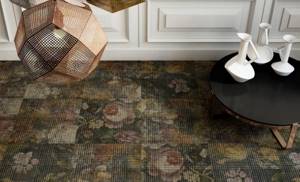
The carpet will decorate the interior
If the choice was not carpet, but you really want comfort. Then a nice fluffy or low-pile carpet will give his room a nice touch. Of course, there is no point in placing it right at the entrance. Also, if you have beautiful flooring, you don’t need to cover it completely with carpet. It is enough to lay a small rug in the center of the hallway. If the floor layout is square, it is recommended to choose a round or oval rug. If it is elongated or goes into a long corridor, then it is recommended to lay a carpet instead of a carpet.

Laminate or parquet board?
Flooring manufacturers try to create things that meet most consumer requirements. One of the modern options that has literally been on everyone’s lips for several years now is, of course, laminate. It is known that nege has different degrees of wear resistance, from 31 to 34. For the hallway it is recommended to choose from class 32 and above
Laminate class does not mean the totality of all physical characteristics. It does not include indicators such as moisture resistance, impact resistance and density. This only means the degree of abrasion - which indicates how quickly the floor will be worn. It is assigned depending on the thickness of the top polyurethane layer.
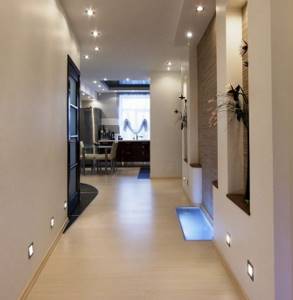
It is possible to use laminate flooring for the hallway. Because it really is not easy to scratch. It has sufficient hardness. The variety of its designs is unlimited. The only thing worth focusing on is the joints. Since most laminates on HDF boards absorb moisture over time - this happens at the joints, it is recommended that for a hallway in which there is always a possibility of water getting in, choose a laminate with chamfers.
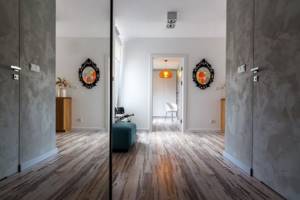
Parquet boards for the hallway and even for the corridor are not recommended. Firstly, a standard board is varnished; even the most durable varnish is easier to scratch than the laminate surface, which consists of polyurethane. Secondly, thin veneer 2-4 mm, usually glued to soft pine, is pressed through quite easily. All it takes is a small pebble to get under the heel and a dent is guaranteed.

It is also worth noting that parquet boards are a material that cannot be classified as cheap. Of course, if the task is to create an environment without signs of consumer goods, then for such a floor you will have to pay from 2000 rubles per sq.m. and higher.
Laminate, in turn, costs at least two times less, and lasts at most three times longer. So, which floor is better for the hallway is an individual decision.

